The Patient Acquisition Challenge for Medical Practices
Is your medical practice struggling to attract new patients? In today’s digital landscape, a strong online presence is crucial for growth. This is why leveraging Google Ads for doctors can be a game-changer, helping you reach potential patients and outshine competitors.
Today’s post explores how Google Ads and PPC advertising can transform your patient acquisition strategy and drive impactful practice growth.
Why Google Ads Matter for Doctors
Google Ads has revolutionized medical marketing for doctors and specialists. Nowadays, patients who need healthcare-related information start their quest for answers with an online search.
Google is the most popular search engine, making Google search results prime real estate for healthcare clinics looking to attract new patients.
Medical-related searches on Google number in the billions annually, with a significant percentage specifically seeking local providers. Your presence on the Google search results page can be the difference between a thriving practice and one that struggles to grow.
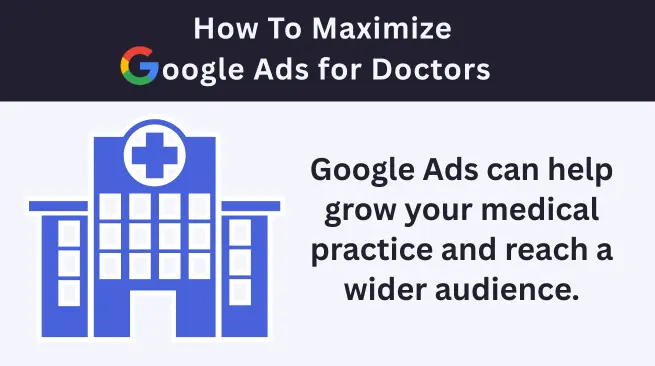
Unlike traditional advertising, Google Ads for doctors offers unprecedented targeting capabilities. This precision ensures your online ads reach the right audience at the right moment—when they’re actively searching for the specific medical services you provide.
The ability to create targeted ads tailored to specific patient concerns provides an advantage that traditional advertising simply cannot match.
Google Adwords (now officially called Google Ads) has become an essential tool for healthcare practices nationwide. The platform’s sophisticated targeting options enable doctors to reach their target audience with remarkable precision and measurable results.
Identifying Your Ideal Patient Audience
Well-crafted Google Ad campaigns for doctors begin with understanding your target audience. Different medical specialties attract different demographic profiles, and your ads targeting should reflect this reality.
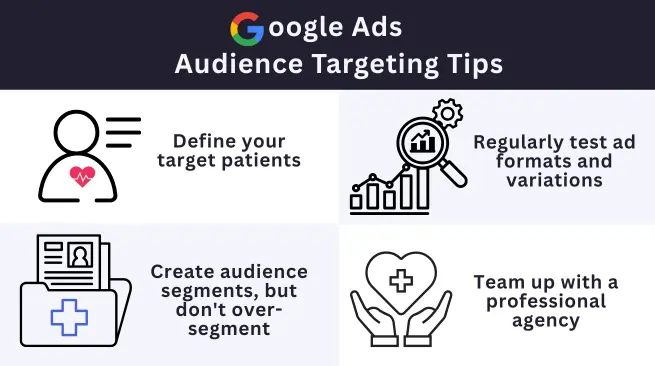
Start by analyzing your current patient base. Which demographics constitute your most valuable patients? What keywords do they use in a Google search for your services? What are their geographic locations? How about household income? Consider these factors that align with your practice’s strengths.
Google’s audience targeting capabilities ensure your online ads generate maximum return by focusing exclusively on your right audience. By defining your ideal patients, you can configure your Google advertising campaigns to reach precisely the right audience at the moment they’re searching for your services.
Effective medical marketing requires speaking directly to patient needs. Google Adwords enables doctors to target patients based on numerous factors including search history, device type, and even time of day, creating opportunities for hyper-relevant messaging.
Keyword Research: The Foundation of Healthcare PPC
Effective keyword research separates high-performing Google Ads for doctors from ineffective campaigns. The right keywords connect your practice with patients searching for your specific healthcare services.
Begin with the Google Keyword Planner to identify high-value search terms in your healthcare specialty. Focus on medical-related searches with clear intent—terms like “dermatologist near me” or “pediatric dentist appointment” indicate users ready to become patients.
Don’t overlook the power of negative keywords in your PPC ads strategy. These prevent your ads from appearing for irrelevant searches, protecting your ad spend from wasteful clicks that won’t convert to appointments.
For doctors new to Google PPC ads, starting with highly specific keywords often yields better initial results. Rather than competing for broad terms like “doctor,” focus on your specialties and geographic area to maximize relevance and conversion potential.
Google Adwords success begins with understanding the language your patients use. The most effective ads for doctors speak directly to patient concerns using the exact terminology they enter into search engines.
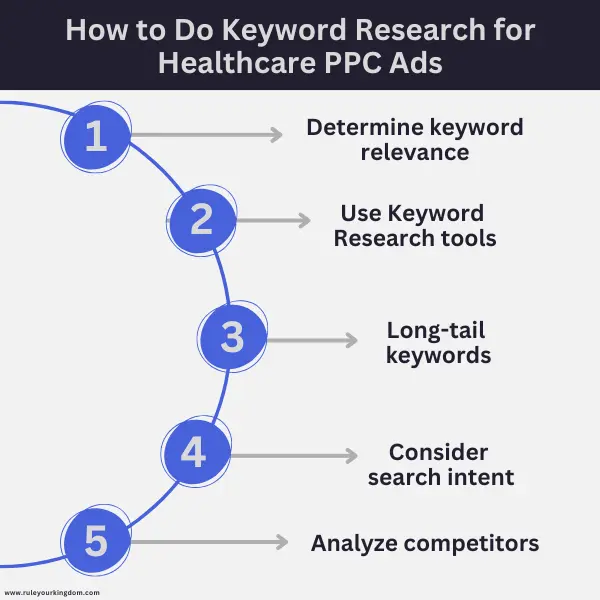
Geographic Targeting for Local Medical Practices
Healthcare is inherently local. Patients typically seek providers within a reasonable distance from their homes or workplaces. Local search ads allow you to focus your Google advertising on these proximity-based searches.
Configure your Google Ads for doctors campaign to target specific geographic locations where your ideal patients live and work. For specialists, this radius might be larger than for general practitioners, reflecting patients’ willingness to travel for specialized care.
Mobile optimization becomes particularly important with local targeting. Patients searching on mobile devices often have higher intent, making these mobile-first users especially valuable to healthcare providers running Google Ads.
Creating Compelling Ad Copy for Healthcare Services
In the competitive healthcare field, generic messaging won’t cut through the noise. Your online ads must speak directly to patient needs and concerns.
Focus on what truly differentiates your practice. These unique selling points should feature prominently in your ad formats. High-quality ad copy for Google PPC ads requires both art and science. Testing multiple variations helps identify messaging that resonates most strongly with your target users, leading to higher click-through rates and better quality scores.
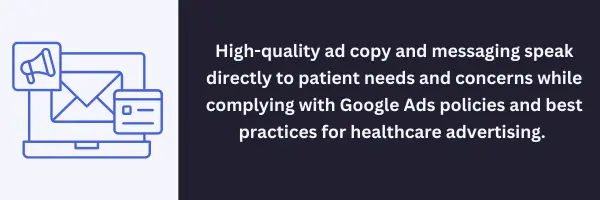
For maximum effectiveness, your practice’s ad formats and copy should address specific patient pain points. Rather than simply listing services, focus on the benefits patients receive—faster relief, convenient scheduling, or specialized expertise in treating particular conditions.
However, always maintain compliance with Google Ads policies for healthcare advertising. A professional agency knows how to comply with Google’s advertising regulations for medical professionals.
Structuring Your Medical Practice’s Google Ads Campaign
Effective campaign structure improves both performance and manageability. Most successful Google Ads campaigns for healthcare professionals utilize multiple ad groups organized by service line or patient need.
For example, a family practice might create separate ad groups for annual physicals, pediatric care, and women’s health services. This structure allows for highly relevant keywords, ad copy, and landing pages for each service category.
This organization also facilitates more efficient budget allocation. You can adjust your Google Ads budget at the campaign or ad group level, directing more resources toward your most profitable service lines.
Well-structured PPC ads campaigns make it easier to manage campaigns effectively over time. By organizing your Google Ads for doctors into logical groupings, you can quickly identify what’s working and what needs refinement to attract more patients.
Online advertising success for medical and healthcare practices depends on alignment between keywords, ad copy, and landing webpages. The right structure ensures patients find exactly what they’re searching for, leading to higher conversion rates and better return on investment.
Optimizing Ad Extensions for Healthcare Providers
Ad extensions expand your presence on the search results page without increasing your cost per click. For healthcare clinics, these additional elements provide crucial information that can influence patient decisions.
Site links extensions allow you to highlight specific services, making it easier for potential patients to navigate directly to relevant information. Location extensions display your practice address and phone number, facilitating immediate contact.
Call extensions are particularly valuable for healthcare professionals, as many patients prefer speaking directly with office staff. This extension places a clickable phone number in your ad, enabling one-tap calling from mobile devices.
Implementing all relevant ad extensions is essential for maximizing the performance of Google PPC ads in the healthcare sector. These enhancements not only improve click-through rates but also provide valuable information that helps convert clicks into actual appointments.
For doctors utilizing Google Adwords, ad extensions represent a significant competitive advantage. They increase your visibility on the search results page while simultaneously providing patients with multiple ways to engage with your practice.
Landing Page Optimization for Patient Conversion
Even the best Google PPC ads will underperform if they direct website traffic to poorly optimized landing pages. This is why your website visitors should find exactly what they’re looking for without confusion or frustration.
Create dedicated landing webpages for each major service category. These pages should maintain message consistency with the ads that lead to them, reinforcing the specific benefits that prompted the initial click.
Include clear calls-to-action for appointment scheduling or online consultation requests. Every landing page should make the next step obvious, whether that’s calling your office, completing a form, or booking through an online system.
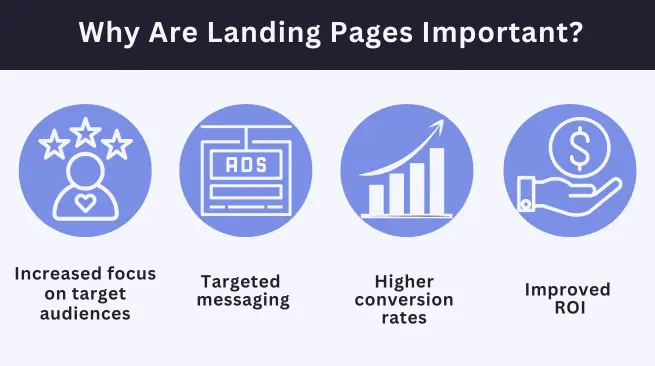
The effectiveness of ads for doctors depends heavily on post-click experience. Landing pages should load quickly, present information clearly, and make scheduling appointments as frictionless as possible to maximize conversion from visitor to patient.
Optimizing landing webpages specifically for Google Ads traffic can dramatically improve conversion rates. By aligning page content precisely with ad messaging, you create a seamless experience that builds trust and encourages potential patients to take action.
The Critical Role of Negative Keywords
Negative keywords prevent your ads from appearing for irrelevant searches. This targeting refinement is particularly important in the healthcare industry, where many medical terms have multiple contexts.
For example, a cardiologist wouldn’t want their ads appearing for searches like “heart-shaped cookies” or “valentine’s day hearts.” By adding these as negative keywords, you protect your advertising costs from wasted clicks.
Regular search term report analysis helps identify new negative keyword opportunities. This ongoing refinement ensures your ads reach only the most relevant audience and maximizes the efficiency of your marketing budget.
Conversion Tracking for Medical Practices
Without proper conversion tracking, you’re essentially running your ad campaigns blindfolded. Defining and monitoring conversions allows you to measure actual return on investment, not just clicks or impressions.
For medical practices, primary conversions typically include appointment requests, phone calls, and online form submissions. Configure Google Ads to track these specific actions to understand which keywords and ads drive actual patient acquisition.
Privacy considerations are paramount when implementing conversion tracking for healthcare providers. Ensure all tracking complies with HIPAA requirements and never captures protected health information in your Google advertising systems.
Setting an Appropriate Google Ads Budget for Healthcare
Determining the right ad budget requires understanding the economics of your practice. Calculate your average patient lifetime value to establish how much you can profitably spend to acquire a new patient.
Start conservatively and scale based on performance data. Initial campaigns serve as learning opportunities, providing insights into which keywords and approaches yield the best results for your specific practice.
Remember that competition varies significantly by specialty and location. Competitive analysis tools like SpyFu can provide insight into what other practices in your area spend on similar target keywords.
Mobile Optimization: Essential for Modern Patient Acquisition
More than half of health-related searches occur on mobile devices. This trend makes mobile web design optimization non-negotiable for doctors running Google Ads campaigns.
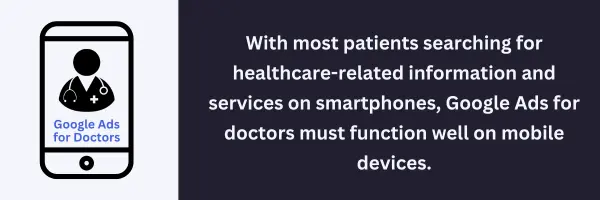
Ensure your landing pages load quickly and display properly on smartphones and tablets. Mobile users have particularly low tolerance for slow-loading sites, and a poor experience can send potential patients to competitors.
Consider implementing click-to-call functionality throughout your site. Mobile users often prefer calling to filling out forms, and removing friction from this process improves conversion rates significantly.
Google Ads for doctors should always prioritize the mobile experience. With most users searching for healthcare professionals on smartphones, practices that deliver excellent mobile experiences attract more patients than those with desktop-only optimization.
PPC ads that lead to mobile-friendly landing pages consistently outperform those that don’t. For healthcare clinics, this mobile-first approach means simpler forms, larger touch targets, and prominent display of phone numbers to facilitate immediate contact.
Remarketing to Interested Prospective Patients
Not every website visitor converts on their first visit. Remarketing allows you to reconnect with these potential patients as they browse elsewhere online, serving as a gentle reminder of your services.
Develop different remarketing strategies based on visitor behavior. Someone who visited your “services” page has different needs than someone who abandoned an appointment request form halfway through completion.
For healthcare clinics, remarketing requires sensitivity. Set appropriate frequency caps to avoid appearing overly aggressive, and consider excluding certain content categories for brand safety.
Remarketing represents one of the most cost-efficient aspects of Google Adwords for medical practices. By focusing on users who have already shown interest, these targeted ads typically deliver higher conversion rates than standard search campaigns.
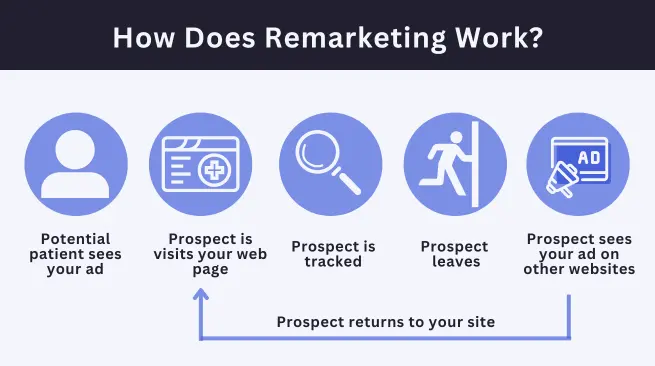
The best PPC ads strategies for doctors include thoughtful remarketing components. This approach keeps your practice top-of-mind with potential patients during their decision-making process, which can sometimes extend over several days or weeks.
Measuring Success: Key Performance Indicators for Medical Advertising
Effective campaign management requires focusing on the right metrics. While impressions and clicks provide some insight, conversion metrics reveal the true impact on your practice’s growth.
Track cost per acquisition alongside absolute conversion numbers. This efficiency metric helps you understand not just if you’re gaining more patients, but whether you’re acquiring them profitably.
Monitor impression share to understand your visibility relative to competitors. If this metric is low, you may be missing opportunities due to budget constraints or poor quality scores that could be addressed.
Quality Score Optimization for Healthcare Advertisers
Google’s Quality Score significantly impacts both ad placement and cost per click. For doctors, achieving high quality scores reduces advertising costs while improving visibility in search engine results.
Three factors primarily determine Quality Score: click-through rate, ad relevance, and landing page experience. Focus on tight keyword-to-ad-to-landing page alignment to excel in all three areas.
Regular account audits help identify underperforming elements that drag down overall quality. Address these issues promptly to maintain competitive positioning in the increasingly crowded healthcare advertising space.
Navigating Google Ads Policies for Healthcare Services
When it comes to online advertising for the healthcare industry, Google maintains specific policies for health-related content. Violations can result in ad disapproval or account suspension.
Certain sensitive health categories require certification before advertising is permitted. This is why it’s vital to familiarize yourself with restrictions regarding specific treatments, conditions, and claims.
When crafting ad copy, focus on complying with policies to further strengthen your practice’s online reputation.
Leveraging Ad Groups for Service-Specific Targeting
Strategic organization of your Google Ads account improves both relevance and manageability. Create distinct ad groups for different services, conditions treated, or patient demographics.
This structure allows you to craft highly specific ads and select the right keywords for each aspect of your practice. A pediatric dentist, for instance, might have distinct segments for first visits, orthodontics, and emergency care.
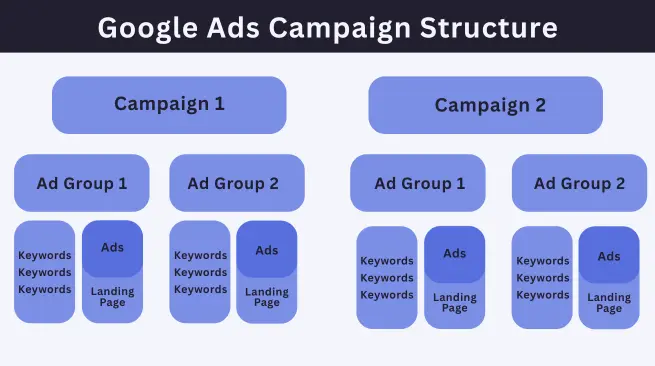
Multiple ad groups’ granularity also facilitates more meaningful performance analysis. You can quickly identify which services generate the most interest and adjust your strategy accordingly.
Seasonal Strategy Adjustments for Medical Advertising
Google Ads campaign should adapt to the fluctuating needs of patients accordingly. Many medical services experience predictable seasonal demand patterns worth leveraging.
Allergy specialists see increased searches during peak pollen seasons, and orthopedicists may see more sports injury queries during school athletic seasons. To maximize patient acquisition, plan an increased ad budget during these high-demand periods.
Sophisticated Google Ads for doctors campaigns incorporate seasonal timing into their strategy. By anticipating when demand for specific medical services peaks, practices can ensure their online advertising aligns with patient needs throughout the year.
The most effective PPC ads adjust dynamically with seasonal trends. For example, dermatologists might focus on skin cancer screenings in summer months, while shifting toward acne treatments when school years begin.
Competitive Analysis in Healthcare Advertising
Understanding your competitors’ advertising strategies provides valuable context for your own campaigns. Tools like SEMrush and SpyFu reveal competitors’ most successful keywords and ad copy approaches.
However, don’t just mimic competitor strategies. Instead, look for gaps in their messaging that align with your practice’s unique strengths. These uncontested areas often provide the most efficient patient acquisition opportunities.
Remember that larger healthcare systems typically have bigger advertising budgets but may lack the agility of smaller practices. Your ability to quickly adjust to performance data can be a significant advantage in digital marketing.
Advanced Audience Targeting for Medical Specialists
Specialty healthcare practices benefit from advanced patient targeting beyond basic demographics. Interest-based targeting reaches potential patients based on their online behavior patterns and research topics.
In-market audience identification reveals users actively researching related health topics. For example, someone researching “knee pain causes” might be an excellent prospect for an orthopedic practice specializing in knee treatments.
Custom intent audiences allow you to reach users searching for specific competitor names or related treatment options. This strategy helps capture patients at the critical comparison stage of their provider selection process.
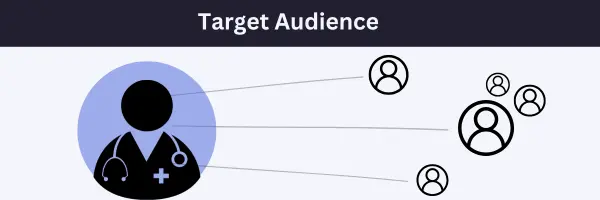
The most sophisticated Google Ads for doctors leverage these advanced targeting capabilities to reach highly qualified prospects. By combining demographic, geographic, and behavioral data, specialists can create ads that speak directly to their ideal target audience.
For truly excelling medical marketing, consider layering multiple targeting methods. This approach creates highly specific audience segments, allowing you to craft PPC ads that address precise patient concerns and dramatically improve conversion rates.
The Role of Search Engine Optimization Alongside PPC
While Google Ads delivers immediate visibility, organic search results through SEO provide long-term value. The most successful healthcare digital marketing strategies leverage both channels synergistically.
Use insights from your PPC advertising to inform your medical SEO efforts. Keywords that convert well in paid campaigns often deserve focus in your organic content strategy as well.
Landing pages developed for Google Ads can be expanded into comprehensive information resources for SEO purposes. This content depth improves both user experience and organic search visibility.
Testing and Optimization for Continuous Improvement
The most effective Google Ads campaigns evolve through systematic testing and optimization. Implement regular A/B testing of ad copy variations to identify messaging that resonates best with potential patients.
Test different calls-to-action to determine what motivates your specific audience. Some patients respond better to “Schedule Now” while others prefer “Learn More” as their entry point.
Landing page testing is equally important. Experiment with different layouts, form lengths, and trust indicators to identify the combination that maximizes patient conversion rates.
Amplify Patient Acquisition Through Google Ads
Google Ads for doctors represents a pivotal opportunity for medical practices seeking sustainable growth. The platform’s targeting precision and measurable results make it uniquely valuable in the healthcare marketing landscape.
Success requires thoughtful strategy, ongoing optimization, and attention to healthcare’s unique regulatory environment. Practices that master these elements gain a significant competitive advantage in their local markets.
For many healthcare clinics, professional management of Google Ads campaigns delivers the best results. The complexity of healthcare advertising often warrants specialized expertise to navigate effectively and maximize return on advertising investment.
Implementing effective PPC ads can transform a medical practice’s growth trajectory. With strategic keyword selection, compelling ad copy, and optimized landing pages, doctors can consistently attract a steady stream of new patients who are specifically searching for the medical services they provide.
Online advertising through Google Ads offers unprecedented efficiency compared to traditional marketing channels. The ability to measure exactly which ads for doctors generate appointments makes it possible to continuously refine your approach and achieve increasingly better results over time.
Taking the Next Step
Ready to transform your practice’s online presence and patient acquisition strategy? It’s time to leverage Google Ads for doctors and medical providers.
While impactful, this patient acquisition strategy is not a set-it-and-forget-it solution. Regular monitoring and refinement based on performance data will ensure your medical practice realizes the full potential of Google advertising campaigns.
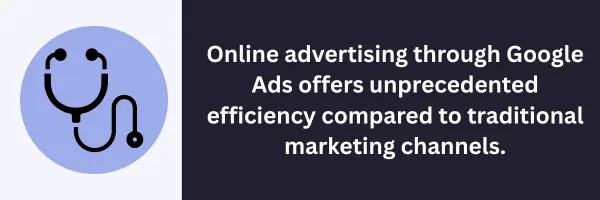
Working with a certified Google Ads expert helps you roll out highly targeted online advertising campaigns that connect your practice with precisely the right patients at the moment they’re actively searching for your healthcare and treatment services.




